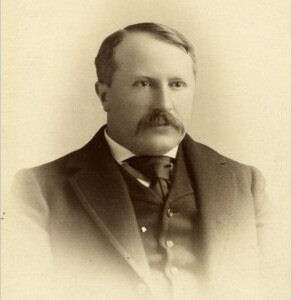Israel C. White
| Israel Charles White | |
|---|---|
 I. C. White about 1898 | |
| Born |
November 1, 1848 Monongalia County West Virginia, U.S. |
| Died |
November 24, 1927 (aged 79) Baltimore Maryland, U.S. |
| Citizenship | American |
| Alma mater | West Virginia University, Columbia School of Mines, University of Arkansas |
| Known for | Geology of West Virginia |
| Scientific career | |
| Fields | Geology |
Israel Charles White (Monongalia County, West Virginia, United States, November 1, 1848 - Baltimore, Maryland, November 24, 1927) was an eminent geologist and professor, internationally known, and the first state geologist of West Virginia.
White was born on a farm in Battelle district[1] of western Monongalia County and grew up in Morgantown.[2] White graduated from West Virginia University in June 1872 with a bachelor's degree in Geology[2] and did postgraduate studies in Geology and Chemistry from Columbia School of Mines and received a doctoral degree from the University of Arkansas in 1880. He began his career in 1875 as an assistant geologist in Pennsylvania. In 1877 he assumed the chair of Geology at West Virginia University.[3] He worked as a geologist at the West Virginia Geological and Economic Survey for thirty years and became its first director.
He was the first to correlate the coals of Pennsylvania and Ohio and also the first to apply the Anticline Theory to locate wells for oil exploration. He insisted that the theory was tested in West Virginia, and the discovery and development of Mannington oil field in 1889, proved the theory and convinced the oil industry of its importance. This fact redirected the entire industry and created a great demand for their services in the location and definition of regions favorable for petroleum deposits. With its use, there was a dramatic increase in the discovery of new oil.
In 1904 he was hired by the Brazilian government as head of the "Comissão de Estudos das Minas de Carvão de Pedra do Brasil" (Commission for Studies on Brazilian Coal Mines), whose aim was to identify the potential of Brazilian coal, and whose report, published in 1908, was a milestone for understanding the geology of the Paraná Basin in Southern Brazil. One of the main results of these studies, besides the reconnaissance for coal, was the discovery of Mesosaurus fossils within Permian black shales (Irati Formation), and the Glossopteris flora within the Permian coals. White was one of the first to propose the equivalence between the South American Permian strata and similar rocks of the Karoo Basin in South Africa.[4] This report had an important contribution to the development of Continental Drift Theory, published by Alfred Wegener in 1912.[5]
He was the Treasurer of the Geological Society of America in 1892–1907[6] and its president in 1920.[7][8]
Notes
- ↑ Staff (25 November 1927) "Dr. I. C. White, State Geologist, Dies Suddenly: Passes Away After Slight Operation" Morgantown Post obituary, reprinted under title "Israel Charles White" by the West Virginia Division of Culture and History, last accessed 21 October 2010
- 1 2 "About Geology and Geography at West Virginia University: History of the Department" West Virginia University
- ↑ "Morris, Sir Daniel". International Who's Who. 1912. p. 1089.
- ↑ White, I.C. (1908) "Comissão de Estudos das Minas de Carvão de Pedra do Brasil – Relatório final": Commission for Studies on Brazilian Coal Mines - Final Report; (Bilingual report, Portuguese & English) DNPM, Rio de Janeiro, Brazil, Parte I, p. 1-300 ; Parte II, p. 301-617; (facsimile edition: 1988).
- ↑ Wegener, Alfred (July 1912). "Die Entstehung der Kontinente". International Journal of Earth Sciences (in German). 3 (4): 276–292. Bibcode:1912GeoRu...3..276W. doi:10.1007/BF02202896.
- ↑ "White, Israel C." International Who's Who. 1912. p. 1089.
- ↑ Fairchild, Herman LeRoy, 1932, The Geololgical Society of America 1888-1930, a Chapter in Earth Science History: New York, The Geological Society of America, 232 p.
- ↑ Eckel, Edwin, 1982, GSA Memoir 155, The Geological Society of America — Life History of a Learned Society: Boulder, Colorado, Geological Society of America Memoir 155, 168 p., ISBN 0-8137-1155-X.
References
- "Israel Charles White" West Virginia Division of Culture and History, obituary from the Morgantown Post 25 November 1927
- "History of WV Mineral Industries - Oil and Gas" West Virginia Geological and Economic Survey, Department of Commerce, West Virginia
- "About Geology and Geography at West Virginia University" West Virginia University
- Allison, Lee (30 June 2008) "Arizona Geology: 100 years of AASG", State Geologist, Arizona Geological Survey